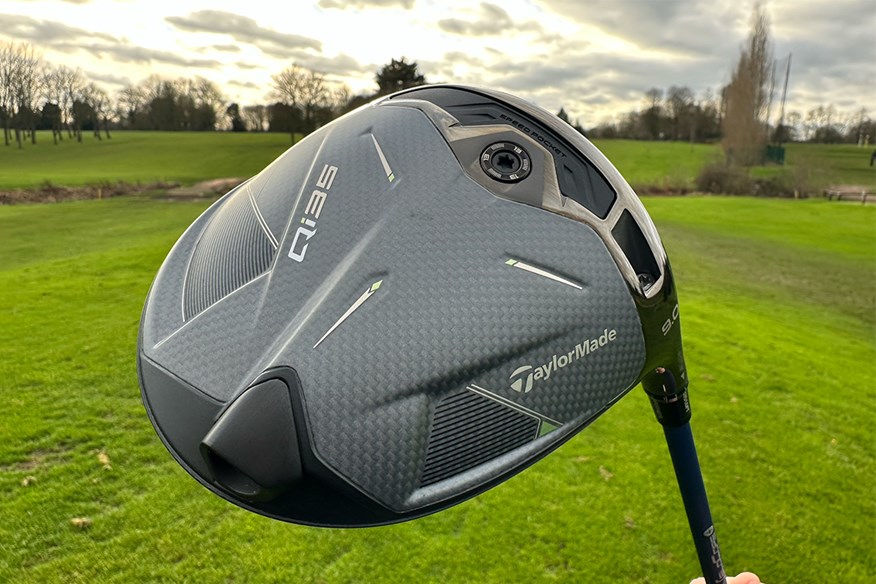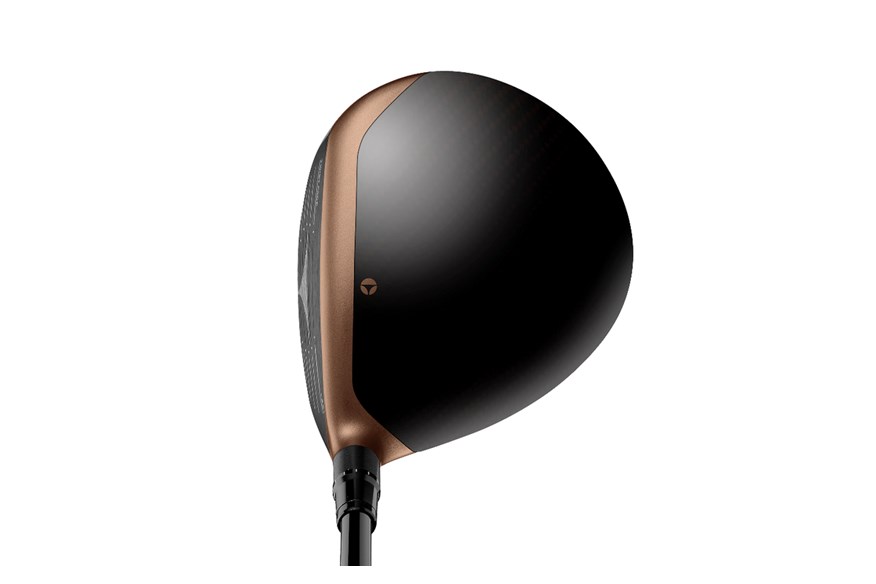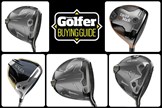Ready To Upgrade Your MOI? Say Hello to The Best TaylorMade Drivers of 2025
Last updated:

What is the best TaylorMade driver for you? Our launch monitor-backed test reveals all.
The best TaylorMade drivers have been at the forefront of golf club innovation for more than 40 years as the company name is down as producing some of the best golf drivers of all time.
TaylorMade’s first steel-headed driver – the Pittsburgh Persimmon that launched in 1979 – helped revolutionize the club-making industry and, in the mid-2000s, the TaylorMade R7, the first movable weight driver, was another major innovation. Since 2021 the company has dedicated itself to making carbon face drivers which they insist improve the impact efficiency of the most recent 2023 Stealth 2, 2024 Qi10 and 2025 Qi35.
Today, TaylorMade makes three main driver options for shots from the tee, there’s also a BRNR mini driver that can be used from the tee (possibly as a driver replacement), and so long as you have plenty of speed the fairway. No matter, whether you’re Rory McIlroy, a decent club player, or a beginner golfer there’s a TaylorMade driver out there for you, here’s my rundown on how to choose which is best for your game in 2025.
Best TaylorMade Driver – Jump to:
- What type of driver do you need?
- The Best TaylorMade Driver
- How we tested the drivers
- Buying Advice & FAQs
What type of driver do you need?
Low Spin
The best low-spin drivers have more weight positioned closer to the face rather than towards the rear like more forgiving models. By stacking weight in a more forward position the center of gravity (the point the club rotates around) is drawn closer to the face. With a more forward center of gravity (CG) low spin drivers react differently at impact compared to back-weighted forgiving models. It’s this impact reaction that reduces spin.

Thanks to their more forward CG low-spin drivers have lower MOI ratings, which means they are less forgiving on off-center strikes. Low spin drivers typically work best for golfers with above-average levels of swing speed, as speed typically generates more spin. Low spin drivers will generally produce faster ball speeds than more back-weighted models (as more mass is located closer to the impact location), so they’re often the longest but least forgiving option and golfers need decent levels of speed to get the best out of them.
It’s no secret that golfers who hit the longest drives have upward attack angles onto the back of the ball (which reduces spin and adds distance much more so than downward driver attack angles), so low spin drivers are often designed to compliment this motion. It’s entirely possible if a low spin driver is put into the hands of a downward attack angle golfer spin rates will increase and not reduce. TaylorMade’s best low-spin driver option in 2025 is the Qi35 LS, although we have found all models of 2025 to have low spin with the correct fitting.
Draw Bias/Easy to Square
The average club golfer has a handicap of 18 with a typical swing speed hovering around 92/93 mph. Research has shown a majority of these players will hit shots from left to right with a slice (for a right-handed golfer). ‘Slicers’ create more spin, which robs distance and shots frustratingly end up down the right side of the golf course, so most golf club brands produce a ‘Draw Bias’ driver to help counteract the effects of a slice. Ping make the G440 SFT, Callaway makes the Elyte X whereas TaylorMade’s offering is the Qi35 Max.

The Qi35 Max is a little different from most ‘draw drivers’ as TaylorMade says it has been designed to be an ‘easy to square’ model (as they believe golfers don’t understand what draw bias does or means). Draw bias drivers have weight positioned more towards the heel, so the head naturally wants to rotate around this heel side center of gravity at impact, which closes the face and helps counteract the effects of a slice.
Lots of golfers believe draw drivers are their most forgiving driver option, however as heel weight is usually further forward than an all-out forgiveness model like the Ping G430 Max this isn’t always the case. An exception to the rule is the TaylorMade Qi35 Max which has an MOI of 10,000 gcm2 and is the company’s easiest to square and most forgiving model ever, providing lower spin and a more optimal CG projection than its predecessor, the TaylorMade Qi10 Max.
Forgiving/All round performance
If you don’t have a super-fast swing speed and a slice doesn’t plague your game it’s highly likely you’ll benefit from a driver that offers a blend of both distance and forgiveness. Modern all round performance drivers typically have a tiny bit of left bias built in (for right-handers), so their center of gravity location sits somewhere between low spin and the best draw models.

The most forgiving drivers are a great option for golfers prone to spraying shots across the entire face of their driver. TaylorMade’s Qi35 falls within this category, as does the Callaway Elyte, Ping G440 Max, and Titleist GT2.
Mini Driver
Mini Drivers are a pretty modern invention they can serve several purposes for very different players. Mini Drivers have a smaller head size, which is more aerodynamic than a typical driver (300cc rather than 460cc). The size reduction means it’s possible to pick up speed, so even though Mini Drivers usually come with higher lofts (11.5° or 13.5°) golfers can often see very little distance difference between the pair. Some golfers see the Mini Driver as an alternative to their regular driver off the tee, the shorter shaft length can boost confidence, improve consistency, and up accuracy while giving up very little in terms of ball speed and distance.

The smaller head size and extra loft mean higher speed players, like Tommy Fleetwood hit the Mini Driver from the fairway (expect a stronger loft than most fairway woods) which can bring the very longest of Par 5s within reach in two shots. Mini Drivers can be a really versatile option, but from all the testing we’ve done you will need strong levels of speed to launch one to a good peak height to get maximum distance from the fairway.
If you’re looking to use the TaylorMade BRNR Mini Driver more from the tee I’d suggest looking at the 11.5° loft whereas if you’re after a super strong option from the fairway the 13.5° loft would be a more sensible choice.
Best TaylorMade Drivers: At a glance
Best for lowering spin: TaylorMade Qi35 LS | VIEW OFFER
Most forgiving: TaylorMade Qi35 Max | VIEW OFFER
Best for overall performance: TaylorMade Qi35 | VIEW OFFER
Most versatile: TaylorMade BRNR Mini | VIEW OFFER
Best for slicers: TaylorMade Qi35Max | VIEW OFFER
Best value for money: TaylorMade Qi10 | VIEW OFFER
Best for women golfers: TaylorMade Kalea Gold | VIEW OFFER
Best TaylorMade Drivers 2025
The low launch low spin weapon in TaylorMade's Qi35 family
TaylorMade have outdone themselves with the Qi35 LS, in terms of how much distance is on offer. With the fastest ball speed and carry yardage from any driver this year, it’s an outstanding product for those looking for pure power. There’s a legitimate argument to be made that the Qi35 LS could have made it into our best drivers of 2025 top 3, but we were concerned that this head may not be viable for golfers who miss the centre of the face. If you can keep control of your strike and direction though, you won’t beat this driver in 2025.
With spin at 2,256 RPM, expect a low penetrating ball flight with this model. An interesting note in 2025 here is that some professional golfers such as Rory McIlroy have not yet switched into the Qi35 LS, due to the high performance of the previous iteration.
You can read our full review of the TaylorMade Qi35 LS Driver here
Key drivers test data:
Ball Speed 167.0 mph | Carry 298.0 yards | Spin (Total) 2,256 rpm | Launch Angle 13.0º | Height 38.2 yards | Descent Angle 40.3º | L-R Dispersion 23.3 yards
Pros
- Best Low Spin Driver Award winner of 2025
- Outstanding Modern Looks
- The Longest Driver of 2025
Cons
- Not forgiving enough for all golfers' needs
| RRP | £529.00 / $649.00 |
| Lofts | 8º (RH), 9° / 10.5° (RH/LH) |
| Head Size | 460cc |
| Lie | 56º |
| Stock Shaft Length | 45.75” |
| Stock Shaft Options | Mitsubishi Kai’Li Blue DarkWave CB 60g / Mitsubishi Kai'Li White DarkWave 60g |
| Stock Grip | Golf Pride Z-Grip Black/Silver |
- Ultra Low Center of Gravity
- Multi-Material Construction
- High Moment of Inertia Design
- Trajectory Adjustment System
- Carbon Twist Face
10,000 MOI just got an upgrade for 2025
In testing, our pro player found the Qi35 to deliver exceptionally consistent results, though it didn’t clock the highest speeds. Neil particularly appreciated the club’s appearance at address, praising the look of the chromium carbon finish, which appealed even to seasoned players. While it might not be an essential upgrade over the TaylorMade Qi10, it remains one of the most forgiving drivers for 2025, and a great choice for a high handicapper looking for a premium model with a seriously impressive amount of forgiveness. The TaylorMade Qi10 Max is still a worthy option in 2025, but expect slightly higher spin which may not suit some.
TG Test Pro Data:
Ball Speed: 162.3mph | Backspin: 2825 rpm | Carry: 275.4 yds | L-R Dispersion: 16.7 yds
Read our full TaylorMade Qi35 Max driver review.
Pros
- Chromium Carbon material adds to the confidence at address.
- Lower CJ Projection for optimal launch and spin.
- The extreme shape and weighting might mean you can use a little less loft to get more ball speed.
Cons
- Large playing profile may be offputting for some.
| Lofts | 9° / 10.5° / 12º (RH/LH) |
| Stock shafts | Fujikura Air Speeder 50g / Mitsubishi Diamana T+ 60g |
| Stock grip | Golf Pride Z-Grip Black/Silve |
High performance in a large forgiving head
The standard model offers a ton of performance in both categories mentioned above, while not sacrificing in either direction. The feeling that comes to mind when hitting this driver is similar to how I felt when I first hit the OG M2 in 2016 - a real unicorn offering that you'd be hard-pressed to find a golfer that this doesn't work for.
A respectable variety of stock shafts (and the ability to order this with Tiger's upcharge Tour AD-VF shaft) adds to the appeal that the crowd of golfers playing Taylormade drivers already are well aware of. The carbon face, now in darker blue has a more subtle muted sound and feel compared to other brands out there helping it to stand out in the bay when you first try them.
A small bonus, for those who like to stand out amongst their peers, is that Qi35 is available in multiple colors in what Taylormade is calling 'Designer Series', giving you the chance to make the driver truly yours.
Read our Full Review of the Taylormade Qi35 Driver.
TG Test Pro Data:
Ball Speed: 163 mph | Backspin: 2287 rpm | Carry: 283.7 yds | L-R Dispersion: 27 yds
Pros
- Plenty of power on offer
- More forgiving than anything Taylormade has previously made
- Designer Series is a cool way to stand out from the rest
Cons
- Adjustability isn't as extensive as other brands
| Lofts | 9º / 10.5º / 12º |
| Stock Shafts | Fujikura Air Speed 50g / Mitsubishi Diamana T+ 60g |
| Stock Grip | Golf Pride Z-Grip Black/Silver |
Versatility from the tee and fairway




He hit the BRNR (with its heaviest – 13.5g – weight in the back port to maximize launch and forgiveness) and his own driver from a tee, along with the BRNR and a Ping G430 Max fairway wood from the turf.
We like the BRNR’s look, feel, and sound, and with its retro shaft not being the strongest or stoutest, there’s extra help here for players attempting to launch shots from the turf.
From the tee, it gave up 7.3mph of ball speed and 12 yards of carry against our test pro’s own driver, his favorite club. From the deck the strong-lofted BRNR didn’t carry as far as the 15° Ping fairway, it did outrun it for total distance though, while shots launched and flew lower, and span less. Surprisingly, the lower loft also hit shots into a 23% tighter shot area than the Ping.
So is it worth buying one? If driving is your strength, probably not. But if you struggle to control a driver, the smaller but powerful head of the BRNR could be an absolute godsend. And if you’re a golfer who hits 3-wood a lot from the tee, the BRNR is a bigger, more forgiving, and powerful option.
TG Test Pro Data (BRNR Mini 13.5° from a tee):
Ball Speed: 155.2 mph | Backspin: 2613 rpm | Carry: 260 yds | Shot Area: 750 yds2
TG Test Pro Data (Own Driver 10.5° from a tee):
Ball Speed: 162.2 mph | Backspin: 2249 rpm | Carry: 282 yds | Shot Area: 656 yds2
TG Test Pro Data (BRNR Mini 13.5° from the turf):
Ball Speed: 152.7 mph | Backspin: 2702 rpm | Carry: 244 yds | Shot Area: 911.2 yds2
TG Test Pro Data (Own Fairway Wood 15° from the turf):
Ball Speed: 152.5 mph | Backspin: 3043 rpm | Carry: 257 yds | Shot Area: 1183.2 yds2
Read our full TaylorMade BRNR Mini Driver review
Pros
- The smaller head size is fast
- A versatile option
- The retro cosmetics are really appealing
Cons
- Only really a viable fairway wood option for a small group of higher speed players
| Lofts | 11.5° / 13.5° |
| Stock shaft | UST Mamiya ProForce 65 - Retro Burner Edition |
| Stock grip | Golf Pride TaylorMade Victory Copper |
If it ain't broke, don't fix it
Best Value for Money


As amateur golfers, perhaps we should do the same, given we can purchase it at a better price point in 2025 to the majority of the competition.
The quest for inertia started with the TaylorMade Qi10 family, and the Qi10 core model provided a healthy amount of MOI with speed that appealed to the everyday golfer and many more.
We saw the likes of Rory McIlroy, Brooks Koepka and Scottie Scheffler trial this driver in 2024 and beyond. If you're looking to budget your driver build for 2025, the TaylorMade Qi10 is a fantastic choice.
Read our Full Review of the Taylormade Qi35 Driver.
Pros
- Excellent for golfers who want forgiveness but insist on playing a familiar TaylorMade head shape.
- A good blend of distance and forgiveness.
- The infinity crown is way nicer to look at than previous models.
Cons
- CJ Projection not as optimal as Qi35 family.
| Lofts | 9º / 10.5º / 12º |
| Stock Shafts | Fujikura Air Speed 50g / Mitsubishi Diamana T+ 60g |
| Stock Grip | Golf Pride Z-Grip Black/Silver |
Much like the TaylorMade Qi10 driver, the Kalea Premier boasts tour-proven tech (carbon crown and sole with an aluminum back ring and an Inertia Generator at the back of the sole) which have all been tuned to offer slower swing speeds and higher launch with additional MOI forgiveness.
Golfers also get the brands Twist Face tech which promotes increased consistency on common mishits from the low-heel and high-toe areas of the face. A flexible Thru-Slot Speed Pocket in the sole also helps retain ball speed for shots impacting low on the face.
Pros
- A very easy-to-launch driver option
- The shaping and profile are great
- The cosmetics are really appealing
Cons
- You don't get a carbon face, but at lesser speeds it has less impact
| RRP: | £449 |
| Lofts: | 11.5° and 13.5° |
| Stock Shaft: | 44” Kalea Gold Ultralight Graphite 40-L |
| Stock Grip: | SuperStroke Traxion Tour Navy/White 37g |
Data comparison: How the 2025 TaylorMade drivers compare in numbers
| Driver | Ball Speed | Launch Angle | Backspin | Height | Descent Angle | Carry Distance | L-R Dispersion |
| TaylorMade Qi35 LS | 167 MPH | 13.0° | 2256 RPM | 38.2 YDS | 40.3° | 298 YDS | 23.3 YDS |
| TaylorMade Qi35 | 163 MPH | 11.8° | 2284 RPM | 32.5 YDS | 38.7 | 283.7 YDS | 27 YDS |
| TaylorMade Qi35 Max | 162.3 MPH | 11.4° | 2825 RPM | 35.7 YDS | 51.3° | 275.4 YDS | 16.7 YDS |
Watch: The Best Drivers 2025 video
How we tested the drivers
To test golf equipment, we create a controlled indoor environment at Keele Golf Centre and use a premium tour-level golf ball (the TaylorMade TP5x). We collect data from every shot our test pro is happy with, using a Foresight GC Quad launch monitor. The women’s Kalea Gold driver was tested by TG Deputy Editor Sarah Pyett.
Find out more about how we test golf equipment.

Why do we use a pro tester?
Speak to any golf club engineer about product testing and they all talk about needing a repeatable, reliable strike to offer any sort of valuable comparison. So, whilst we accept not all of the equipment included within our tests was designed for our test pro, what our data shows is a great comparison of how clubs in each particular category differ, which is hugely valuable in helping you narrow your choice as a consumer.
In 2024 we’ve tested over 50 different drivers in many different settings, during which our test pro has needed to delete very few mishit shots. He’s hit the flag from 300 yards, he has hit fades, draws and nailed countless shots straight at his target, and he will also regularly hit 300 driver shots in a day. In short, Neil Wain is the perfect club tester due to his consistency in delivering accurate and reliable comparative data and he loves hitting balls all day long.
We would of course always recommend attending a proper fitting session, to ensure any purchase is tailored to your game.
Best TaylorMade drivers: buying advice & FAQs
What does the ‘Qi35’ name mean?
In 2024, the Qi name was an amalgamation of the brand’s ‘Quest for Inertia’ and hitting the ‘10K’ barrier. An idea spurned by the company’s quest to produce the world’s most forgiving driver, without compromising on speed.
In 2025, we’ve seen the 10 upgrade to 35. 35,000 MOI you say?
I wish.
The ‘3’ stands for the three pillars behind the Qi35 family: form, function and fit. The ‘5’ is for the five different heads that are available for consumers to use during their fitting.
Should I consider buying a second-hand TaylorMade driver?
Absolutely do not write off buying a used TaylorMade driver, the brand has made plenty of excellent models over the years. Obviously, any used model from previous years won’t have the very latest game-improving technology built-in but many golfers would argue it’s hard to spot marginal gains between successive models. The average life expectancy for a driver is around five years, so you will see a difference between 5 – 8 year old models and the Qi35 available today.
If you really want a forgiving driver, you can still look at the Qi10 Max from 2024, as it offers 10,000 MOI at a much more affordable price in 2024. You may not receive the same performance as the Qi35, but it’s still a high-performing driver for the amateur golfer.

Which tour pros play TaylorMade drivers?
A decade ago TaylorMade was famous for paying huge swathes of tour pros to play their driver as part of their business model evolved around being the most played driver out on tour. Back then they even went so far as to trademark the ‘#1 Driver on Tour” slogan so no other brand could use it. Today the thinking at TaylorMade has changed, the company is now focused on a smaller group of elite athletes who play multiple TaylorMade products.
You’ll find TaylorMade drivers in the hands of Scottie Scheffler, Rory McIlroy, Collin Morikawa, Tommy Fleetwood, Nelly Korda, Charley Hull, and Brooke Henderson among others which means the brand is consistently seen to be winning on tour.
Which TaylorMade driver is most forgiving?
Without a doubt, TaylorMade’s most forgiving driver is the Qi35 Max, its MOI forgiveness rating is over 10,000 gcm2 like the Ping G430 10K Max and PXG Black Ops. If ultimate forgiveness is your goal this is the model for you.
How often does TaylorMade update their drivers?
A decade ago TaylorMade had a reputation for launching new products and within six months updating and superseding them with brand new models. Over time golfers got seriously annoyed at the practice, so much so the company has learned its lesson and these tactics have been banished from the business today.
Over the last 8 years, the company has committed to launching one new family of drivers (usually with three models to choose between) each January, with the addition of a new Mini Driver or Women’s family being introduced in the mid-season.









